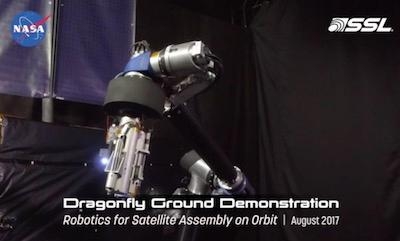Wed, Sep 13, 2017
Demonstrates Confidence In Public Private Partnership For Space Robotics
SSL, a leading provider of innovative satellites and spacecraft systems, today announced that NASA has awarded the next phase of funding for its ground-breaking Dragonfly on-orbit satellite assembly program. The contract modification to move forward with the detailed design of a semi-autonomous robotic system for in-space satellite assembly confirms NASA's confidence in SSL and the success of this "Tipping Point" public private partnership, which is enabling the development of new technology that benefits both government and commercial space endeavors.

SSL and its partners, which include MDA, NASA, and Tethers Unlimited, recently successfully completed a ground demonstration of the Dragonfly developments to date. The demonstration included an ultra-light robotic system and advanced command and control software that is designed to make use of existing spacecraft equipment and capabilities, including a standard geostationary (GEO) spacecraft platform and processor. It proved SSL's concept of highly dexterous on-orbit operations that are expected to drive next generation satellite architectures.
"NASA relies on commercial innovation as exemplified by the Dragonfly team," said Trudy Kortes, TDM program executive at NASA Headquarters in Washington. "Transformative technologies such as these will, in time, lead to more affordable, safer human access to space and more efficient, longer-lasting satellites, probes and other space hardware. Today our future in space looks brighter and more robust than ever."
"SSL has a history as an early adopter of innovative technologies that improve satellite performance," said Dario Zamarian, group president, SSL. "Our work with NASA to develop next-generation robotic assembly on orbit has the potential to change the way satellites are built and launched and will also be important for future space architectures that support exploration and deep space missions. We are pleased to have NASA's continued support of this important work, which is critical to our nation's leadership in space."
(Image from NASA-SSL Video. Source: SSL news release)
More News
Aero Linx: Model Aeronautical Association of Australia MAAA clubs are about fun flying, camaraderie and community. For over 75 years, the MAAA has been Australia’s largest fl>[...]
Touchdown Zone Lighting Two rows of transverse light bars located symmetrically about the runway centerline normally at 100 foot intervals. The basic system extends 3,000 feet alon>[...]
“Discovery and innovation are central to our mission at Virgin Galactic. We’re excited to build on our successful record of facilitating scientific experiments in subor>[...]
How To Get A Story On Aero-TV News/Feature Programming How do I submit a story idea or lead to Aero-TV? If you would like to submit a story idea or lead, please contact Jim Campbel>[...]
Student Pilot Reported That During Rotation, “All Of A Sudden The Back Of The Plane Kicked To The Right..." Analysis: The student pilot reported that during rotation, “>[...]
 ANN's Daily Aero-Linx (05.02.24)
ANN's Daily Aero-Linx (05.02.24) ANN's Daily Aero-Term (05.02.24): Touchdown Zone Lighting
ANN's Daily Aero-Term (05.02.24): Touchdown Zone Lighting Aero-News: Quote of the Day (05.02.24)
Aero-News: Quote of the Day (05.02.24) ANN FAQ: Contributing To Aero-TV
ANN FAQ: Contributing To Aero-TV NTSB Final Report: Cirrus Design Corp SR20
NTSB Final Report: Cirrus Design Corp SR20



